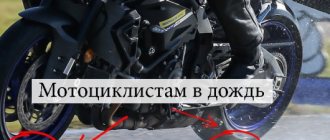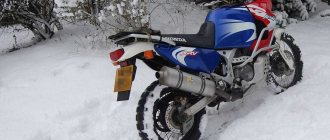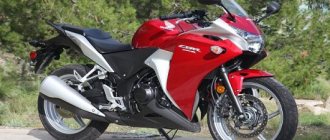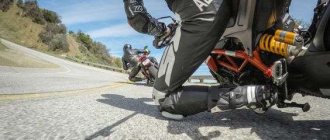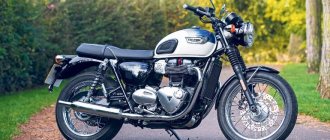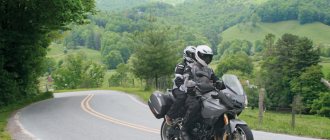It is widely known that car drivers and motorcyclists do not like each other, and sometimes they are even enemies fighting for influence. People traveling on the road by car believe that they have more rights than motorcyclists or other road users, although the traffic rules do not give them this right. Motorcyclists often create dangerous situations on the road with their reckless and even brazen behavior.
What should a driver do to ensure a safe motorcycle ride?
Tip 1 – motorcycle riding culture
A motorcyclist is not a more privileged road user than a car or bus driver. No one is forced to change from the left lane to the right to make room for a speeding biker behind them. However, if the driver does behave this way, it is good to thank him for it - with a nod or a raise of his hand. You should always signal your desire to change lanes and ensure that no one behind you attempts a similar maneuver. Thanks to this, you will avoid danger on the road.
Slow ride
Let us immediately note that riding a motorcycle slowly is much more difficult than riding a motorcycle quickly. This is due to the fact that at low speed it is more problematic to maintain balance. In addition, you need to get the hang of reacting to the behavior of the bike by squeezing the clutch or adding gas. After all, driving very slowly with the clutch lever fully released will not work; the engine will stall. Conversely, if you fully depress the clutch, the engine torque will not be transmitted to the wheels.
It is necessary to find and feel the optimal combination of clutch lever and throttle position. The engine must run stably, and the motorcycle must move very slowly. The gas and clutch in this exercise must be considered as a whole. To reduce speed, you can either let off the gas or squeeze the clutch a little harder. This exercise is designed to bring the combination of clutch and gas to automaticity. The pilot must squeeze the clutch and turn the gas intuitively. And don’t be afraid that you’ll burn the clutch. On most bikes, the clutch discs are in an oil bath, and it is almost impossible to burn them.
To perform this exercise correctly, you need to find an empty area or parking lot with a normal asphalt surface. Next you need to measure the length of 33.5 meters. You need to drive along a straight line at a minimum speed. The slower the better. It is necessary to select such a position of the clutch lever and throttle handle so that the engine speed is stable, and at the same time the motorcycle rides at a minimum speed. When driving slowly, try not to look down and to the sides. The head should be raised and looking forward. It is necessary to maintain balance with the help of the vestibular apparatus, and to stay on the line is necessary through lateral vision. If you manage to drive slowly and smoothly, then you need to try to reduce the speed further. To do this, select a new clutch and gas combination. It is necessary to constantly reduce the speed and do this gradually. There is no need to try to go as slowly as possible the first time. The main goal of this exercise is to learn to feel the gas and clutch.
You need to do the “Slow Riding” exercise for 20 minutes, three times a week. After 1-2 months, you need to reduce your speed to such an extent that you will travel a distance of 33.5 meters in 20 seconds or more. If you have achieved this result and feel confident in this type of riding, then you can reduce the number of classes to once a month.
This exercise is best done before or after a trip. If you don’t succeed the first time, don’t give up. You need to have patience. This is much more complicated than it seems at first glance. It takes a lot of effort to master slow driving to perfection.
Tip 2 – Adjust the speed of the motorcycle
Under no circumstances should a motorcyclist treat the public road as a race track to test the performance of his motorcycle. Driving on one wheel, stalling at a crowded roundabout or making sharp turns and burning rubber at traffic lights are ways to create dangerous situations. It also reinforces the belief that motorcycle users are reckless, arrogant and irresponsible.
Eight
This exercise is a training exercise and is designed to teach you how to make a turn in a confined space. Since turning in a narrow place is one of the most difficult maneuvers for almost every motorcyclist, this exercise must be approached with special responsibility. After all, at low speed, any bike loses balance and becomes unstable. Turning at low speeds is very rare in everyday life, so most motorcyclists do not develop the skills for this maneuver at all. It is worth noting that most pilots find turning left easier than turning right. This is because when turning, the steering wheel is turned as much as possible, while one hand is pressed against the body and the other is extended. So, for most motorcyclists it is more convenient to work with the clutch with a bent hand, and with the gas - with an outstretched hand
.
It is worth noting that when performing maneuvers at low speed, you cannot use the front brake. Even the slightest braking of the front wheel can cause you to fall into the corner. You need to slow down using the rear brake, gas or clutch.
“Figure Eight” is the best exercise that helps you master turns. After all, the “eight” is two turns in different directions. You need to start the exercise in an empty parking lot, or any area with sufficient area. After all, the figure of eight should not have restrictions on the sides. In this case, when the motorcycle stalls, you can add gas and go forward. This will help you avoid falling.
To complete the exercise, you need to place two landmarks along the edges of the figure. Ideally, these will be traffic cones. But you can use any available items, for example, bricks. You need to start from 12 meters. For the first time, you can try a larger distance, which needs to be reduced little by little. As the distance between the extreme points decreases, the driver's skill increases. When you feel confident in this exercise with 12 meters between the ends of the figure, move to a distance of 9 meters. After 9 meters, try to conquer the 6-meter figure eight. This 6-meter maneuver is the standard for the American motorcycle police. But it is worth noting that some motorcycles do not allow you to perform a “figure eight” six meters long, since their steering wheel does not turn to such a large angle. The maximum level for such motorcycles will be “eight” with the handlebars turned out to the maximum.
The main subtleties of the exercise:
- You need to look where the motorcycle is going. It is necessary to turn your head as much as possible so that the maximum trajectory of movement falls into view.
- When starting the first turn, you need to look in the opposite direction of the figure (at another cone or brick), and in the middle of the turn, the head should already be turned to the entrance to the next turn.
- During the entire exercise, you should not tilt your body. It must be in an upright position at all times. Only the motorcycle can be tilted.
- If possible, try applying maximum pressure on the kickstand from the outside of the motorcycle. Try to stand on the outer stand with all your own weight, and at this moment take the motorcycle into a turn. At this moment, it is imperative to control the clutch and gas.
- The head should not tilt during any maneuvers. The head must be kept strictly upright.
- Take breaks from time to time. This way you can rest and the motorcycle can cool down.
This exercise must be performed for 60 minutes. This should be done once every two weeks.
Important nuances that you should pay attention to when performing the Figure Eight exercise:
- You cannot steer while turning. The steering wheel must be turned to the required angle immediately and the position of the steering wheel must not be changed until the turn is completed. Changes in the turning radius can be influenced by speed. If the motorcycle falls over, then you need to increase the speed a little, but if it goes into a turn with a large radius, then the speed needs to be reduced.
- Connect the rear brake to the control of the motorcycle. You must learn to control a bike using a combination of three components: gas, clutch and brake. It is the rear brake that allows you to perform a turning maneuver more sharply.
Tip #3 – Don’t race between cars
"Attention! Motorcycles are everywhere » Motorcycles usually travel faster on the road than cars, so they can flash in the driver's mirror without him noticing the rider. Unfortunately, the consequences of this situation can be tragic.
Online traffic rules exam 2021 at the traffic police - traffic rules tickets with answers
Therefore, a prudent motorcyclist will ride so that others can see him. The motorcyclist should always be aware that the driver of the car may not be able to see him in the rear view mirror - it is important to maintain an appropriate safe distance from the vehicle, avoid and, if necessary, adjust the speed. The so-called principle of limited confidence, because due to inattention, lack of sufficient visibility or ordinary human stupidity, an inattentive driver can change lanes into a motorcyclist when changing lanes.
Ban/permission for bikers to move between lanes in 2021 – new bill
In recent years, there has been active development of a law to tighten the liability of motorcycle owners. This applies to cases of non-compliance with lateral distances and maneuvering between rows. The latest bill proposes the introduction of a fine for bikers for driving between rows in the amount of up to 5 thousand rubles. The punishment may also be deprivation of rights for a period of 3-6 months. Discussions are still ongoing about possible changes to the traffic rules.
Assumptions about a ban on the movement of two-wheeled vehicles between lanes are absurd. Many sources have already published incorrect information that motorcyclists have already been banned from riding between rows. In fact, they are not allowed to move along the markings. Tougher rules are only being discussed in the State Duma. Occupying one row with a car, a biker can form a second row in the same lane, observing traffic rules.
Video on the topic:
Tip 4 – Be careful like a motorcycle driver
Safe motorcycle riding requires keen vigilance. The behavior of other road users should be expected. You should also make sure that you are clearly visible on the road even in adverse weather. A jacket with reflective inserts and a brightly colored helmet will definitely increase the likelihood that other drivers will immediately notice the rider.
Friends, I present to your attention my modest work on motorcycle driving safety, which was written a year and a half ago. All the tips, safety principles and recommendations that I managed to collect over several years are collected here. I put my soul into this and I will be happy if the book helps make riding a motorcycle safer. I will be glad if you have something to add, if you have comments, if you disagree with something, if you have a special opinion or want to share your experience. Let's write it together... If anything, my mailbox Considering the BikePost format, I will send one or two chapters so that people can express their opinion. Thanks in advance. Let's go... Sad statistics: In 2009, from May to October, there were more than 17,000 accidents involving motorcyclists. Drivers on two wheels are more often blamed for such accidents (in 13,000 cases). 1,509 people were killed in them, 19,581 (!) were injured in the event of an accident, motorcyclists die 22 times more often than drivers and passengers of cars. And the risk of serious injury is already 40 times higher. Be careful!
Chapter 1. Equipment and protection • Equipment is the most important thing in motorcycle riding, start with it. • Do you want to be alive and healthy? Even if you are going to a bakery five hundred meters away, wear all your equipment. • A helmet is mandatory, without exception, always, there is no other option. • If you are wondering whether or not to wear a helmet, for example, for a short trip, try hitting your head against a wall at a fast walking speed (8 km/h). Hurt? What if the speed is 40 km/h? • Well, okay, I didn’t hit myself, because I’m lucky and careful. What if, at a speed of 60 kilometers per hour, your eye catches a bug or a pebble from under a wheel? • If you are thinking about whether to wear gloves, remember that at a speed of 5 km/h when sliding on your hands, you will leave your skin on the asphalt and will be forced to build it up again. Skin grafting from the thigh to the palm is also painful. • Be visible on the road - choose bright equipment, especially a helmet • In traffic jams, do not open the visor completely - many motorcyclists get windshield wiper fluid in the face when the driver turns on the windshield washer on a nearby car. • Be sure to wear motorcycle boots, at least light ones. It is also very advisable to use motorcycle pants for their intended purpose, and not in the closet. Broken legs (especially if the ankle, pelvis and knees are affected) are very difficult to assemble and heal.
Chapter 2. General principles of driving • FIRST RULE: TAKE RESPONSIBILITY FOR EVERYTHING THAT HAPPENS TO YOU ON THE ROAD. Even if that weirdo with the letter “m” is wrong. Because if you are dead, you no longer care who is to blame in a particular traffic situation. Everything depends only on you. Learn to drive not according to traffic rules, but learn to drive without accidents, regardless of who is doing what on the road. • SECOND RULE: DRIVE AS LIKE NO ONE SEES YOU. NOBODY! • THIRD RULE: DON'T BE IMPRESSIVE AND DON'T FORGET. Most motorcycle accidents are caused by overconfidence, speeding, and lapses in caution. Be afraid of the situation when you start to think that you are a great motorcyclist. This means that you are in mortal danger. Lower your assessment of your abilities just below the level of your skills - move with a reserve. • There is no need to stir up fear in yourself, you just need to be attentive and careful. Driving in a state of terror and thinking about bad things is contraindicated, since fear fetters the mind and thoughts materialize. •Overtaking, maneuvering, speed – the basic rule: if you are not sure and in doubt, don’t do it!!! • Get into the habit of driving not like a fast vegetable (in gas-brake mode), but like a fast supercomputer - evaluate what you see around, play the “what if?” game, calculate the situation ahead of time, look for risks and escape routes. • Remember, no one owes you anything - move in traffic jams, give way, follow traffic rules especially for you that are ignored by other road users. This may not be very fair, but you will save nerve cells if you take this position. And sometimes your life. • Always keep your fingers on the brake and clutch levers - this will save you 15-20 meters of braking distance in a critical situation. • High beams in the city should be turned on, because you will be better noticed. There are several counterarguments to this concept: high beams can blind drivers and prevent them from correctly judging the distance to the motorcycle and its speed. But high beams in the city have more advantages. I've heard of a few accidents caused by a driver being blinded by a motorcyclist, or when a distant motorcyclist was spotted but their speed was misjudged, but "I didn't notice" accidents form the basis of the sad statistics - there are many more of them. However, you need to behave correctly - if you are driving behind a car for a long time and do not intend to overtake it, then switch the headlight to low beam so as not to tire or irritate the driver. • Learn and master counter-steering. This method will allow you to be much more maneuverable in dangerous situations. Please note that counter-steering is used at speeds above “parking” speeds. • Train attentiveness - you may not be noticed, but you must control literally everything that happens on the road. If you feel that your attention has dulled, stop and take a break for 5-10 minutes. It's better to rest on the side of the road than in a hospital bed. • Never relax - most accidents happen within 5 kilometers of your home. • Avoid bravado in heavy traffic, for example, driving much faster than the flow, or horse riding on the rear and front wheels. Otherwise, it’s only a matter of time before your equipment is tested in battle. By the way, do not forget that on the road you are responsible not only for yourself. • There is such a phenomenon as “Gaze Fixation”, it consists in the fact that you often go where you are looking at the moment, and not where you need to go. Don't stare at objects you want to avoid, be it a pole, a hole, or a busty blonde. • Direct your gaze not at the wheels, but forward. The higher the speed, the further we look. •Train the fly in you – in the flow, don’t stop scanning and controlling the situation at 360 degrees, creating more visible space for yourself. • 77% of the danger for a motorcyclist lies in front (accident statistics), 43% is on the front left side. So distribute your attention, but don’t forget about the starboard side and stern. • In heavy traffic, you need to look at the road 3-4 cars ahead - the braking distance, plus a reserve for your reaction (slightly faster than that of a diplodocus). • Train yourself to look not only at the mirrors, but also to turn your head a little, because the mirrors have blind spots that can accommodate entire trucks. Turn your head like Pokryshkin in an air battle. • At the same time, do not turn your head more than necessary to make sure that a specific area is clear, otherwise you may wander off the path of your gaze (see the “Gaze Fixation” phenomenon). • Don’t stare at the mirrors for hours, like a supermodel in the boudoir: look, “photograph” the situation, turn your gaze to the road - at this time the brain itself will digest the picture and give the necessary solutions. • Don't let your eyes dwell on one object for more than a split second, there are still many interesting and dangerous things around. • Pay attention to the sun - when it is blinding, you may not see the car and, most dangerously, when the car is slowing down. • Pay attention to the position of the sun - when it is behind, the motorist may not see you through his rearview mirror, just as you will not see anything in your mirrors due to the blinding light. • No need to lean on the steering wheel - in case of an unforeseen situation it will be more difficult to maneuver. Your hands should be free enough, but you should feel that the steering wheel is controlled easily, without delay, by signals from your vast brain. Try rocking the steering wheel back and forth. • Don't drive if your head is full of problems, if you're tired and your attention is scattered. Tired eyes cling to one object. This is very dangerous - you can experiment and observe the speed of your reaction when you really want to sleep. • Do not drive while hungover or intoxicated. If you drive into the city drunk, you will get the car first of all; if you drive a motorcycle, it may be your last trip. If you don't care, then before you go on a drunken trip, at least call all your loved ones and ask for their forgiveness. • When leaving a closed area (forest, fence) to an open one (field), be careful - you can be blown away by a crosswind, like a sheet of plywood over Paris. • If the wind is sideways, use counter-steering and lean into the wind. Be careful - the gust of wind may suddenly stop, you need to balance back. • When trying to thank traffic participants who let you pass, do not be distracted from the controls and, moreover, do not remove your hands from the brake lever (especially in a traffic jam). You can nod your head, you can blink your emergency lights, in Europe they stick their leg out to the side, for example. • When a convoy of motorcyclists moves on the highway, it is better to break the convoy into small groups of 2-3 people who can maintain the same rhythm of movement. • When riding in a group or in heavy traffic, keep your distance - if a wall grows in front of you, you must have time to stop. • When driving in a group, or in heavy traffic, move slightly to the side of your friend’s track, this will save you from trouble if you are too lazy, or he brakes sharply.
Read part two
Tip 5 – Improving your motorcycle riding technique
Motorcycle users often think they are great at riding and don't need to learn anything else. However, self-improvement in motorcycle riding techniques will improve your safety and get more pleasure from riding two-wheeled vehicles on the road. Professional training for first and second degree motorcyclists is offered, in particular, by the MotoArt driving school (go to website), which has developed an effective training program.
It involves performing basic exercises to improve motorcycle riding technique, as well as working to maintain proper balance. Thanks to completing the courses, the motorcyclist will perform maneuvers accurately, will be able to brake safely and urgently from different speeds, and will be able to behave in difficult situations on the road.
Post Views: 1,673
Jurisprudence on the distance between a car and a motorcycle
Above, we have repeatedly mentioned such an important parameter in traffic dynamics as lateral interval. They also pointed out that the traffic regulations do not specify specific safety values for this distance.
However, not everything is so simple here either! The fact is that there are as many as 2 official acts, which essentially have the ability to indicate the side interval in numbers and have legal force:
- reference book of automotive technical expertise,
- judicial practice 2021.
So, experts have long been able to calculate the value of the safe side interval. And they do this in case of an accident - in fact, it is precisely when there is a precedent for violating clause 9.10 of the traffic rules that this becomes important.
And the calculation formula directly depends on the speed of the vehicle and looks like this:
HP=0.7+0.005 (V1+V2) m,
where V1 and V2 are the speeds of the first and second vehicles.
Let's consider an example: a passenger car is moving at a speed of 60 km/h, but it is ahead of a motorcycle “between the rows”, traveling at a speed of 80 km/h. In this case, the safe lateral interval will be: 9.7+0.005(60+80)=1.4 meters.
Note, however, that this formula is flawed - not everything looks so complicated here, because the difference in speed is only 20 km/h. But if a motorcyclist were driving between the rows at a speed of 120 km/h, then the number of safe lateral intervals would increase to only 1.6 meters.
Accordingly, in general cases, the one who got into the lane (or made an attempt to create a second one) can be considered the culprit in the event of an accident if the lateral interval is not observed.
But there is another calculation method. It simply consists of a value judgment of the safety of the interval based on the personal conviction of the court through an objective examination of all the evidence. By the way, such abstruse words are spelled out in the law - Article 26.11 of the Code of Administrative Offenses of the Russian Federation.
So, in one of the court decisions of the Leningrad Region court it was recognized as legal when a motorcyclist got into the lane of a car at the following distances:
- 1.6 meters from the edge of the car to the markings,
- The width of the motorcycle is 0.78 meters.
Thus, the court recognized 82 centimeters as a safe lateral interval. At the same time, the speed of vehicles was not taken into account at all.
The motorcycle is not for idiots
Each motorcycle model has its own Bible, called the owner's manual. Most often, people turn to her when a problem arises or a question arises about replacing parts or consumable fluids. Here's my advice. Read your motorcycle's owner's manual, and it's best to do this several times. It's a treasure trove of knowledge, including potential problems and solutions and how to fix them.
Do you know how to turn the lights on your motorcycle on and off? Do you remember what the tire pressure should be? Do you know what the icons on the clock or display mean, and do you know the functions of all the switches? This is not secret knowledge, and it is worth having all the information not only in the user manual, but, above all, in your head.
Reset gears
For the same reasons, the operation of the gears is not very smooth at first, and the most common problem is dropping too early or too late. I'm not even talking about engine braking, but a smooth ride around the city. Also remember that if you drop the clutch while moving and you already have the control lever unscrewed, the engine will not stop and the bike will run like crazy, ramming everything and everyone in its path.
Clutch performance on sport bikes varies greatly. So if you have experience on a motorcycle with other specs, be sure to take that into account and approach the clutch with extreme caution.
